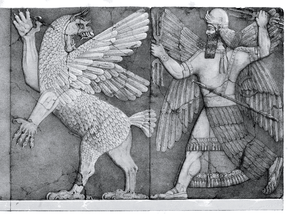Sarpanit
In Babylonian religion, Sarpanit (alternately Sarpanitu, Ṣarpanitu, Zarpanit, Zarpandit, Zerpanitum, Zerbanitu, or Zirbanit)[1] is a mother goddess and the consort of the chief god, Marduk.[2]
| Part of a series on |
| Ancient Mesopotamian religion |
|---|
 Chaos Monster and Sun God |
|
Seven gods who decree
|
|
Other major deities |
|
Demigods and heroes
|
| Related topics |
According to the Chicago Assyrian Dictionary, her name means [Goddess] of Ṣarpān, an otherwise unknown village outside of Babylon.[3] Others explain her name as meaning "the shining one",[4] and she is sometimes associated with the planet Venus. By a play on words her name was interpreted as zēr-bānītu, or "creatress of seed", and is thereby associated with the goddess Aruru, who, according to Babylonian myth, created mankind.[5]
In the documentation available to modern scholars, Ṣarpānītu only exists as a consort to her husband, without personality of her own. Her cult was located in Esagila, the great temple of Marduk in Babylon, where their divine marriage was celebrated during the great akītu ritual at the New Year. Ṣarpānītu also appears in a text given the title Love Lyrics, in which she confronts Marduk for chasing the goddess Ishtar through the streets of Babylon. [6] Other sources describe Ishtar as the wife of Marduk.
Sarpanit was used as a theophoric element in women's names, as was an archaic form of the name, Erua.[7]
She was worshipped via the rising moon, and was often depicted as being pregnant. The Theology of Priesthood, a book to prepare seminary students for a career as a Catholic priest, speculates whether Sarpanit may be the same as Gamsu, Ishtar, and/or Bêlit.[8]
See also
References
- "Za-Zz: Encyclopedic Theosophical Glossary". www.theosociety.org. Retrieved 2016-06-29.
- "When Time Began - 7". www.bibliotecapleyades.net. Retrieved 2016-06-29.
- 'Chicago Assyrian Dictionary Ṣ, 1961, p. 112.
- "SUMERIAN AND AKKADIAN DEITIES". www.atkinslightquest.com. Retrieved 2016-06-29.
- Helmer Ringgren, (1974) Religions of The Ancient Near East, Translated by John Sturdy, The Westminster Press, p. 67.
- Joannès, Francis (2001). "Marduk". Dictionnaire de la civilisation mésopotamienne [Dictionary of Mesopotamian Civilization] (in French). Paris: Laffont. p. 495. as well as the article on Mariage sacré (Sacred marriage) in the same dictionary, p. 509.
- Cousin, Laura; Watai, Yoko (2018). "Onomastics and Gender Identity in First-Millennium BCE Babylonia". Gender and Methodology in the Ancient Near East (PDF). University of Barcelona: Barcino Monographica Orientalia. pp. 243–255. ISBN 978-84-9168-073-4. Retrieved July 10, 2020.
- Goergen, Donald; Garrido, Ann; Ashley, Benedict M. (2000-01-01). The Theology of Priesthood. Liturgical Press. ISBN 9780814650844.